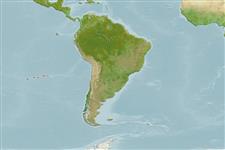Teleostei (teleosts) >
Eupercaria/misc (Various families in series Eupercaria) >
Labridae (Wrasses) > Xyrichtyinae
Etymology: Novaculops: Latin, novacula = razor + Greek, ops = appearance (Ref. 45335); koteamea: Name from the Rapanui word for the fish; 'kotea' is generic for 3 species of wrasses, and 'mea' means red.
More on authors: Randall & Allen.
Environment: milieu / climate zone / depth range / distribution range
Ecology
Marine; pelagic-neritic; depth range 50 - 250 m (Ref. 57578). Subtropical
Southwest Pacific: currently known only from Easter Island, but might be present from southern subtropical islands to the west such as Pitcairn Islands and Rapa.
Size / Weight / Age
Maturity: Lm ? range ? - ? cm
Max length : 25.9 cm NG male/unsexed; (Ref. 89467)
Short description
Identification keys | Morphology | Morphometrics
Dorsal rays IX,12; anal rays III,12; pectoral rays 13. Lateral-line scales 20 + 5. Head naked except for one or two small partly embedded scales dorsally on opercle. Gill rakers 16-18. Body depth 2.6-2.75 in SL. Dorsal profile of snout forming an angle of about 50°, front of head with a slight median ridge. Origin of the dorsal fin a little posterior to preopercular margin; first dorsal spine flexible, slightly longer than second spine, 4.05-4.15 in head length; space between first two dorsal spines two-thirds space between second and third spines. Caudal fin slightly rounded. Pectoral fins short, 1.6-1.7 in HL. Body bright red, edges of scales darker red; membranes of spinous portion of dorsal fin bluish gray, each with a black spot; each of first three membranes of soft portion of fin with a faint black spot (Ref. 57578).
Life cycle and mating behavior
Maturity | Reproduction | Spawning | Eggs | Fecundity | Larvae
Oviparous, distinct pairing during breeding (Ref. 205).
Randall, J.E. and G.R. Allen, 2004. Xyrichtys koteamea, a new razorfish (Perciformes: Labridae) from Easter Island. Raffles Bull. Zool. 51(1):251-255. (Ref. 57578)
IUCN Red List Status (Ref. 130435: Version 2024-1)
Threat to humans
Harmless
Human uses
Tools
Special reports
Download XML
Internet sources
Estimates based on models
Preferred temperature (Ref.
123201): 11.8 - 12.2, mean 12 °C (based on 7 cells).
Phylogenetic diversity index (Ref.
82804): PD
50 = 0.5156 [Uniqueness, from 0.5 = low to 2.0 = high].
Bayesian length-weight: a=0.01047 (0.00408 - 0.02689), b=3.06 (2.84 - 3.28), in cm total length, based on LWR estimates for this (Sub)family-body shape (Ref.
93245).
Trophic level (Ref.
69278): 3.4 ±0.4 se; based on size and trophs of closest relatives
Resilience (Ref.
120179): High, minimum population doubling time less than 15 months (Preliminary K or Fecundity.).
Fishing Vulnerability (Ref.
59153): Low vulnerability (10 of 100).
